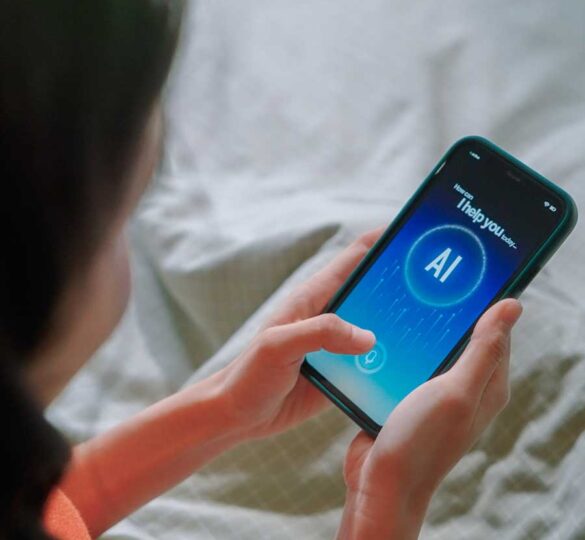Easier Glaucoma Diagnosis with Smartphone Apps and Artificial Intelligence
Researchers are working on some amazing things that artificial intelligence (AI) can do for glaucoma sufferers, especially in the areas of diagnosis and disease management.

Recent exciting advancements in smartphone technology and artificial intelligence (AI) are transforming glaucoma screening, making it more accessible and efficient. These innovations are especially critical in the fight against glaucoma, a leading cause of irreversible blindness often referred to as the ‟silent thief of sight.”
A study published in Eye, the scientific journal of the Royal College of Ophthalmologists, reveals an alarming trend: more than 90% of glaucoma cases in developing countries go undetected. Even more troubling, over half of those diagnosed already have advanced disease, and nearly 20% are blind at the time of diagnosis. A critical shortage of glaucoma specialists further compounds the growing crisis. However, advances in AI-powered diagnostic tools and smartphone-based imaging systems are making early screening more accessible, offering new hope for preserving vision and improving patient outcomes.
The Global Challenge of Glaucoma
Glaucoma affects over 80 million people globally, with projections estimating 22 million will be blind from glaucoma by 2040. Alarmingly, many individuals remain unaware of their condition until significant vision loss occurs. Traditional diagnostic methods require specialized equipment and trained professionals, often scarce in low-resource settings.
The Rise of AI-Powered Smartphone Solutions
Innovations in AI and mobile technology are bridging the gap in glaucoma detection, enabling the identification of this sight-threatening disease earlier, more accurately, and in a broader range of settings, including remote or underserved areas where access to eye doctors is limited.
- Medios AI-Glaucoma: In 2023, a study published in Eye evaluated the diagnostic capabilities of the Medios AI-Glaucoma tool, which operates offline and integrates with the smartphone-based fundus camera, PMC+5. The offline AI system demonstrated a sensitivity of 93.7% and a specificity of 85.6% in detecting referable glaucoma. Notably, it outperformed specialists in image grading, identifying 94% of actual glaucoma cases compared to 60% by human experts.
- iGlaucoma: This cloud-based deep learning system analyzes visual field data via a smartphone app. It achieved an area under the curve of 0.966 in clinical evaluations, with sensitivity and specificity rates of 95.4% and 87.3%, respectively.
- BegIA: Developed by researchers in Spain, this app utilizes AI to analyze facial images captured with a smartphone, detecting signs of glaucoma, diabetic retinopathy, and cataracts within seconds, to serve regions with limited access to eye care.
Benefits of Smartphone-Based AI Screening
Smartphone-based AI screening transforms health care delivery by making advanced diagnostics more accessible, efficient, and reliable. These innovative tools harness the power of AI to analyze medical data quickly and accurately, all through a device that fits in your pocket. From reaching patients in remote areas to reducing delays in diagnosis and ensuring consistent results, smartphone-based AI screening is redefining what’s possible in modern medicine.
- Accessibility: Portable and cost-effective, these tools can be deployed in remote areas, reducing the need for patients to travel long distances for screening.
- Efficiency: AI algorithms can process and analyze images rapidly, providing immediate results and facilitating timely referrals.
- Consistency: AI provides standardized assessments, thereby minimizing variability in diagnoses that can result from human error or differing levels of expertise.
Challenges and Considerations
Integrating AI into glaucoma screening is promising for improving early detection and access to care. However, despite its potential, this emerging technology still faces several significant hurdles that researchers and clinicians must overcome before it can gain reliable and widespread adoption in clinical practice.
- Data Diversity: AI models trained on specific populations may not perform equally well across diverse demographic groups.
- Regulatory Approval: Ensuring the safety and efficacy of these tools requires rigorous validation and adherence to medical device regulations.
- Integration into Health Care Systems: Adapting existing workflows to incorporate AI tools requires training and adjustments in clinical practice.
The Future of Glaucoma Screening
The convergence of AI and smartphone technology holds immense potential to transform glaucoma detection by making eye screenings more accessible, affordable, and efficient. Smartphones equipped with AI-powered diagnostic tools can detect early signs of glaucoma remotely or in primary care settings, reducing reliance on specialized equipment and enabling timely intervention, especially in underserved or rural areas.
- Teleophthalmology: Remote screening and consultations can expand reach to underserved populations.
- Continuous Monitoring: AI can facilitate ongoing assessment of disease progression, enabling personalized treatment plans.
- Integration With Other Diagnostic Tools: Combining AI analysis with optical coherence tomography and other imaging modalities can enhance diagnostic accuracy.
Help Us Find a Cure
AI-powered smartphone applications are poised to revolutionize glaucoma screening by making it more accessible, efficient, and consistent. While challenges remain, continued research and collaboration between technologists, clinicians, and policymakers can pave the way for widespread adoption, ultimately reducing the global burden of glaucoma-related blindness.
While there is no cure for glaucoma, advancements in research continue to bring us closer to finding one and restoring vision loss. You can help find a cure by donating cash, stock, or a vehicle. Your support will give hope to those living with glaucoma and accelerate our search for a cure and vision restoration.
The tireless work of researchers continues to enhance our understanding of glaucoma daily. As a result, there is great hope for new and improved treatments, including innovative drug delivery methods, laser treatments, and less invasive surgical techniques. You can help make that happen!
Last updated on June 4, 2025. Article reviewed for medical accuracy by Sandra F. Sieminski, MD.

Sandra F. Sieminski, MD
Sandra Sieminski, MD is a glaucoma and cataract specialist at the Ross Eye Institute and is the Director of Glaucoma Services. She also serves as the Clinical Vice Chair of the Department of Ophthalmology and the Ophthalmology Clerkship Director for the Jacobs School of Medicine and Biomedical Sciences, University at Buffalo/State University of New York (SUNY).